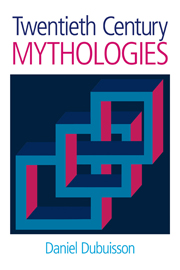Book contents
- Frontmatter
- Epigraph
- Contents
- Foreword by Professor Robert A. Segal
- Preface
- Abbreviations
- Introduction: History and comparative epistemology
- Part I Georges Dumézil, or Society
- 1 The Indo-European background
- 2 The first comparative mythologies
- 3 Durkheim, Mauss, Bourdieu, and Dumézil
- 4 The 1950s: a reorientation
- 5 Comparative and structural evidence
- 6 The new comparative mythology
- Addendum I Theory, history, and the limits of Dumézil's comparativism
- Addendum II Does a Dumézilian theory of religion exist?
- Part II Claude Lévi-Strauss, or the Mind
- Part III Mircea Eliade, or the Sacred
- Conclusion: Modern theories of myth and the history of Western thought
- Bibliography
- Index
5 - Comparative and structural evidence
from Part I - Georges Dumézil, or Society
- Frontmatter
- Epigraph
- Contents
- Foreword by Professor Robert A. Segal
- Preface
- Abbreviations
- Introduction: History and comparative epistemology
- Part I Georges Dumézil, or Society
- 1 The Indo-European background
- 2 The first comparative mythologies
- 3 Durkheim, Mauss, Bourdieu, and Dumézil
- 4 The 1950s: a reorientation
- 5 Comparative and structural evidence
- 6 The new comparative mythology
- Addendum I Theory, history, and the limits of Dumézil's comparativism
- Addendum II Does a Dumézilian theory of religion exist?
- Part II Claude Lévi-Strauss, or the Mind
- Part III Mircea Eliade, or the Sacred
- Conclusion: Modern theories of myth and the history of Western thought
- Bibliography
- Index
Summary
By paying increasingly exclusive attention, from the 1950s on, to structural aspects of the ideology he was studying, Dumézil modified its definition. The “function,” which at first referred to an exemplary social activity (war, agriculture, etc.), evolved until it became an intellectual entity within which diverse concepts and notions confronted each other. At the same time as Dumézil was becoming detached from his sociological model, the global system of the three functions acquired a structural status whose ensemble of figures – that is, its morphology – he was at leisure to analyse. In this situation, and remembering as well the number and diversity of trifunctional examples pointed out up to now, it is necessary to attempt a classification. But the anthological aspect of the latter had to remain marginal in order to give precedence to both a morphological analysis of the diverse figures assumed by the ideology and a specific study of the methodological problems raised by its more unexpected expressions (such as the extension to four or five elements, or the fragmentation of one of the functions).
In response to the criticism launched by those who see in the three functions a more banal formula, it must be recognized that a significant number of trifunctional examples occur as simple enumerations of three juxtaposed terms: symbolically, A + B + C (with the understanding that A, B, and C must correspond to three homogenous terms – three persons, three objects, or three epithets, for example – that are distinct, exhaustive, and plausible).
- Type
- Chapter
- Information
- Twentieth Century Mythologies , pp. 53 - 72Publisher: Acumen PublishingPrint publication year: 2006



